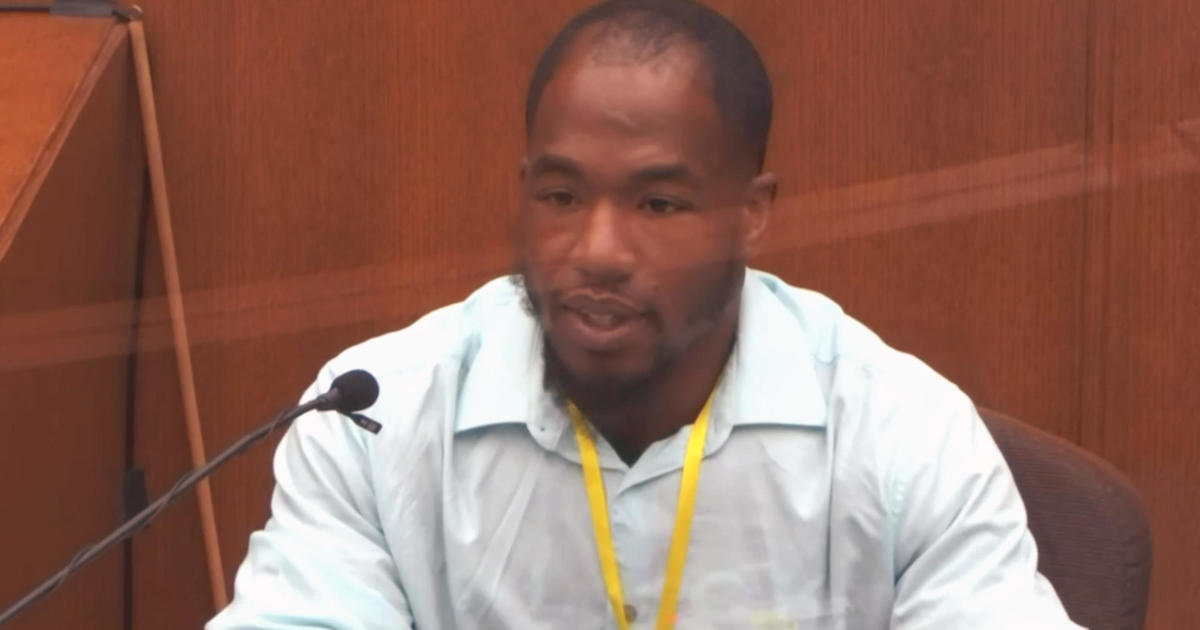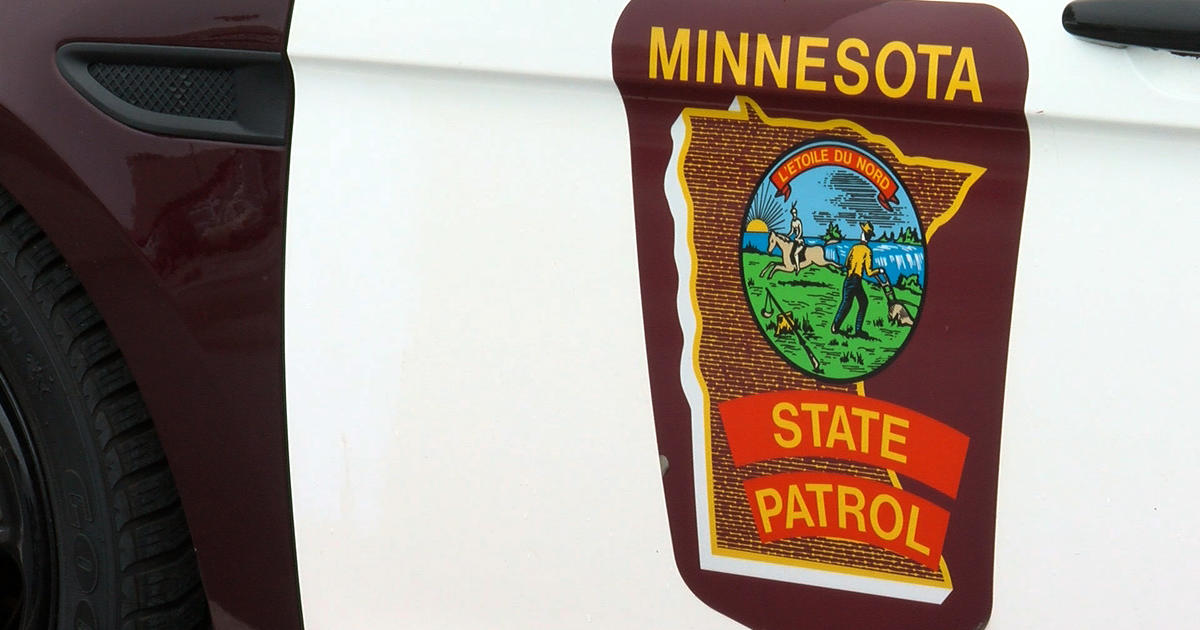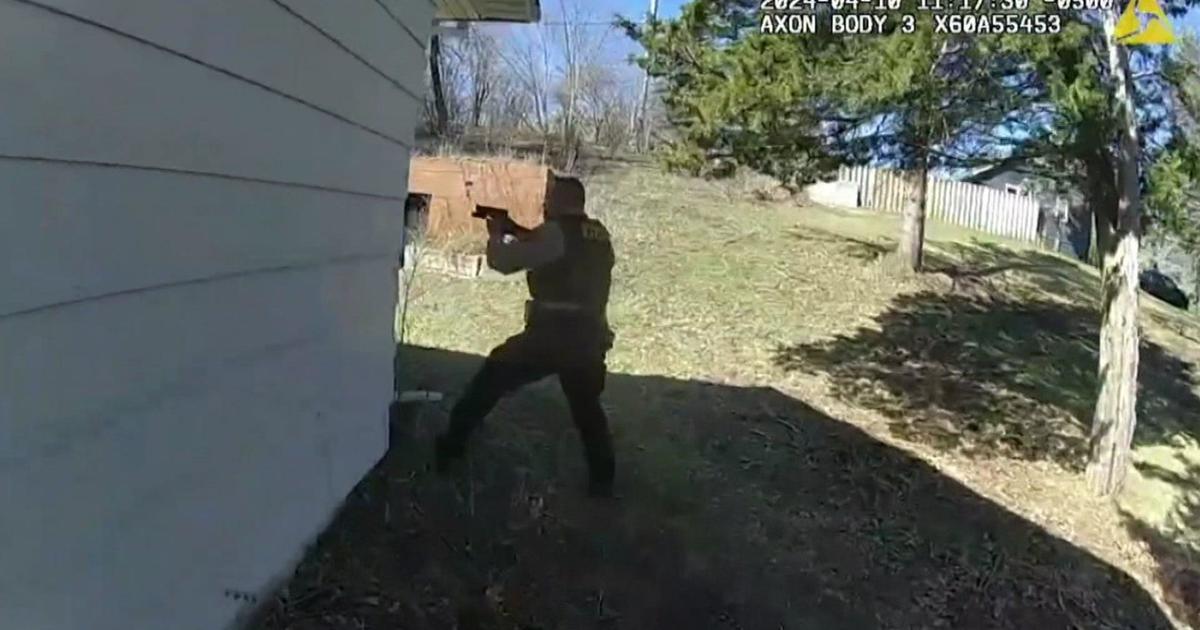Derek Chauvin Trial, April 13 Live Updates: Defense's Use-Of-Force Expert Says Chauvin Didn't Use Deadly Force
UPDATE (4:15 p.m.):The jury has been sent home for the day as counsel discusses potential record issues with exhibits with Judge Peter Cahill.
The last witness of the day, use-of-force expert Barry Brodd, spent his last stretch on the witness stand with the state and defense going back and forth.
Prosecutor Steve Schleicher showed Brodd clips of body camera footage of George Floyd's arrest.
At one point, Brodd said Floyd was becoming "more compliant" as time went on.
"What part of this is non-compliant?" Schleicher asked.
"A compliant person would have both their hands in the small of their back ... resting comfortably," Brodd said.
"Did you say resting comfortably? ... On the pavement?" Schleicher said.
During another clip, Schleicher asked, "From this point until the point at which the EMTs arrive and tap on the defendant's shoulder and take Mr. Floyd and place him on the gurney, Mr. Floyd wasn't resisting, was he?"
"No," Brodd said.
"The defendant retained the same general position?" Schleicher said.
"Yes," Brodd said.
Defense attorney Eric Nelson asked Brodd to describe different police maneuvers, such as the "prone control position" and "swarm maneuver."
"During the course of the restraining of Mr. Floyd, do you continue to see Mr. Floyd actively resist to some degree?" Nelson said.
"Yes, he was struggling," Brodd said.
The defense also hit a point it has touched on with multiple witnesses, showing a clip just before Chauvin took his knee off of Floyd as medics bring a stretcher to the scene. Nelson asked Brodd if, in that clip, it appeared as if Chauvin's knee was on Floyd's shoulder blade. Brodd said yes.
Nelson also asked Brodd multiple times about the issues with showing brief clips of an encounter.
"They don't show the full picture," Brodd said.
Court is in recess until Wednesday morning.
UPDATE (2:30 p.m.): State begins cross-examination of use-of-force expert Barry Brodd.
State begins by asking if Derek Chauvin's positioning on top of George Floyd could produce pain. "It could," Brodd said.
Brodd is asked if a law enforcement officer needs to be, among other things, situationally aware of the suspect's medical condition. Brodd agreed.
State asked "if someone is not resisting and they're compliant, the use of 'control', as you describe it, that could produce pain is just not justified, is it?"
Barry Brodd said "no."
State showed Brodd pictures and videos of George Floyd being put into the prone position and asks Brodd where Chauvin's knees are placed. One picture showed Chauvin's left foot off the ground while he's on top of Floyd. State asked Brodd if that would increase pressure coming down on Floyd. Brodd said that he "doesn't know."
UPDATE (1:30 p.m.): Defense called its first use-of-force expert, Barry Brodd, to the stand.
Brodd, who is a retired police officer out of Santa Rosa, California, has taught defensive tactics, crowd control, chemical agents, impact weapons and something called "verbal Judo", which is when officers are taught to gain compliance from suspects using their words.
Brodd told the defense that, in his expert opinion, Derek Chauvin's use of force wasn't deadly force. He compared it to a scenario where an officer uses a Taser on a suspect fighting with officers, and the suspect falls, hits their head and dies. He said that it's an example of accidental death, not deadly force.
"I felt that Officer Chauvin's interactions with Mr. Floyd were following his training, following current practices in policing and were objectively reasonable," Brodd said.
He said the prone position used for George Floyd was safe for both the suspect and the officers. He added that Floyd was actively resisting on the ground and appeared to kick at one of the officers.
According to Brodd, officers are trained any time they're getting resistance from a suspect, or dealing with a high-risk suspect, that it's safer to take the suspect to the ground. He said that can happen whether or not the suspect is handcuffed.
Brodd said Chauvin also had to deal with the crowd, which Chauvin saw as a bigger threat at one point when he took out his pepper spray. Brodd called Chauvin's use of force "objectively reasonable."
"The crowds started to grow in size, start to become more vocal. So now officers are always trained to deal with right, so what threat is the biggest threat," Brodd said. "Is it the suspect on the ground in front of me in handcuffs that we have relatively controlled? Or is it the unknown threat posed by the crowd that could go from verbal to trying to interfere with my arrest process in a matter of seconds?"
UPDATE (12:09 p.m.): Minneapolis police officer Nicole Mackenzie is recalled to testify for the defense concerning the department's "excited delirium" training. Earlier in the trial, she testified for the state about the department's course for CPR.
When questioned by Eric Nelson, Derek Chauvin's attorney, Mackenzie detailed the training's markers for excited delirium, such as profuse sweating, incoherence and "super human strength." She said that when officers suspect they're dealing with excited delirium, they're trained to call for more help and restrain the suspect until paramedics arrive. Once the suspect is in handcuffs, officers are trained to move them in the side recovery position.
On the body-worn camera footage shown in court throughout the trial, one of the arresting officers, Thomas Lane, can be heard mentioning "excited delirium" as George Floyd is being held down. It's because of this that Judge Peter Cahill allowed Mackenzie to testify on the training new officers, like Lane, receive on excited delirium.
Nelson asked if older officers, such as Chauvin, would have received the same training. Mackenzie said no.
On cross examination, prosecutor Matthew Frank asked if older officers would be trained to move suspects in the recovery position once they become unresponsive or pulseless. Mackenzie testified that they would have.
Excited delirium is a contested condition. Some of the medical experts to testify earlier in the trial said they don't believe it's a real medical condition.
UPDATE (11:32 a.m.): Minneapolis Park Police officer Peter Chang testifies in the trial of Derek Chauvin. He described the crowd that watched George Floyd's arrest on May 25 as "loud and aggressive."
Body-worn camera footage of his time at 38th and Chicago was played in court. On the video, Floyd can be seen sitting at the intersection, giving his name to one of the arresting officers, J. Alexander Kueng, who is charged with aiding and abetting Chauvin in the fatal arrest. Kueng asks Chang to run Floyd's name in the squad computer. That clip of footage was not shown in court.
After, Chang is tasked with watching the two people who were in the car with Floyd. Chang can be heard talking with the two people, one of whom was Shawanda Hill, who testified early Tuesday. The other person, Morries Hall, gave Chang a fake name: "Ricardo." Hall has invoked his 5th Amendment right against self-incrimination in the case.
After an ambulance took Floyd away from 38th and Chicago, Hill can be seen on the video yelling: "Why is [Floyd] going to the hospital?" Chang then responds: "Shawanda, you're not helping."
Not long after, another former witness appears on the video, Charles McMillian, who testified for the state about watching Chauvin pin Floyd down. He tells Shawanda to call Floyd's family, telling her that officers did something to Floyd's neck.
Chang told Eric Nelson, Chauvin's attorney, that he was walking around so much in the video because he was concerned for the officers arresting Floyd, whom he often referred to as his "partners" in the video.
On cross examination, prosecutor Matthew Frank clarified that Chang must have assumed that the officers arresting Floyd were OK, because if they weren't, they would have radioed for help. "Yes," Chang said.
UPDATE (10:40 a.m.): Shawanda Hill, who was with George Floyd in a vehicle before he was arrested on May 25, testified in the Derek Chauvin trial.
She told Eric Nelson, Chauvin's attorney, that Floyd was friendly and talkative while inside Cup Foods but fell asleep when he got into the vehicle. Hill said she had to wake him up when the Cup Food workers approached the car about the fake $20 bill. She also had to wake him up when police arrived.
Prosecutor Matthew Frank asked if Floyd became startled when one of the arresting officers pulled a gun on him. "Very," Hill said.
UPDATE (10:21 a.m.): Retired Hennepin County paramedic Michelle Moseng testifies in the Derek Chauvin trial. She examined George Floyd following his arrest on May 6, 2019, almost a year before his fatal encounter with Chauvin.
Moseng testified that Floyd told her that he took an opioid during the arrest. He also told her that he took several pills in the hours prior. Moseng told the court that Floyd's blood pressure was 216 over 160, adding that she urged him to go to the hospital.
Under cross examination, prosecutor Erin Eldridge asked if Floyd's breathing was normal, if he was alert and if he was able to walk. Moseng testified that Floyd was able to do all those things.
UPDATE (9:37 a.m.): The state has rested its case in the trial of Derek Chauvin.
Immediately after, the defense called its first witness, Scott R. Creighton, a retired Minneapolis police officer who arrested George Floyd on May 6, 2019, almost a year before his fatal arrest at 38th and Chicago.
Judge Peter Cahill instructed the jury not to take this testimony as character evidence against Floyd. Instead, the testimony was to show what happened to Floyd when he ingested opioids during another arrest.
Body-worn camera video of the 2019 arrest was played in court. The short clip showed Creighton approaching Floyd in the passenger seat of an SUV and demanding that he place his hands on the dashboard. "Keep your hands were I can f------ see them," Creighton says. "Keep your hands on the dash."
In cross examination, prosecutor Erin Eldridge asked if Creighton drew his gun when he approached Floyd. He said yes. Eldridge then asked if Floyd said, "Don't shoot me, I don't want to get shot." Creighton confirmed that Floyd said "something like that."
UPDATE (9:16 a.m.): Judge Peter Cahill decides to allow most of the body-worn camera video recorded by a Minneapolis Park Police officer in court. According to the defense, which is expected to begin calling witnesses Tuesday morning, the video shows park police arriving at 38th and Chicago and interacting with the passengers in George Floyd's car.
In a motions hearing before the jury was seated, prosecutors argued that the video contains hearsay and shows George Floyd's personal information when the officer looks him up on the squad computer. On the other hand, Eric Nelson, Chauvin's attorney, argued that the video shows how the officer's attention was split between the people in the car and the bystanders on the street. Throughout the trial, the defense has worked to show that the crowd who watched Floyd's arrest -- and yelled at Chauvin -- were a distraction to officers.
The judge said he reviewed the video and declared it relevant. However, he said that the footage of Floyd's personal information needs to be redacted.
MINNEAPOLIS (WCCO) -- As the Derek Chauvin trial is expected to move into its next phase on Tuesday, with the defense beginning to call witnesses, one question hangs over the proceedings: Will the former Minneapolis police officer take the stand and explain to jurors why he knelt on George Floyd's neck?
Defense attorney Joe Tamburino, who is not affiliated with the case, says that Chauvin, who could testify as soon as Tuesday, is the only person the defense can use to make key points in its case, which is centered around casting doubt on whether or not his actions on May 25 killed Floyd.
RELATED: Prosecution Finishes Questioning Their Last Witnesses In Derek Chauvin Trial
"That jury is going to want to hear [Chauvin] say that he didn't want to hurt Mr. Floyd, that he was just using regular procedures and moves that he's been trained to do," Tamburino said. "You have to humanize the defendant if you're going to try to win....That's really the only way to do it."
However, taking the stand is also a risk for Chauvin. "He just might not come across well," Tamburino said, adding that Chauvin's attorney, Eric Nelson, will have spent considerable time with his client, determining whether or not he should testify.
In court, Chauvin has shown little emotion or character. He sits upright, wears a black face mask and writes notes often on a legal pad. For most days, there is no relative in the seat reserved for his family.
Chauvin is charged second-degree murder, third-degree murder and manslaughter. Prosecutors say that the widely-seen bystander video of Floyd's arrest outside a south Minneapolis convenience store tells jurors all they need to know: That Chauvin knelt on Floyd's neck for 9 minutes and 29 seconds as Floyd lay prone, handcuffed and repeatedly saying he couldn't breathe.
RELATED: Watch WCCO's Gavel-To-Gavel Coverage
Testimony in court is expected to resume around 9:15 a.m. with the defense calling their first witness. WCCO-TV will be streaming the trial live on CBSN Minnesota. Jason DeRusha will lead the coverage, and Tamburino will provide legal analysis.
Judge Peter Cahill told the court on Monday that he expects the defense to wrap up their case by Thursday. If all goes to plan, this will give jurors a long weekend to prepare for being sequestered for closing statements and deliberations next week.
Also on Monday, Nelson, Chauvin's attorney, asked the court to immediately sequester the jury in light of the unrest in the Twin Cities following the fatal police shooting of Daunte Wright. The 20-year-old Black man was fatally shot by a Brooklyn Center police officer during a traffic stop on Sunday. The city's police chief said the officer, identified as Kim Potter, meant to use her Taser on Wright but accidentally shot him.
In court, Nelson argued that the subsequent protests and looting in Brooklyn Center and Minneapolis would affect jurors' ability to come to a not guilty verdict as they could fear the consequences. Yet, the judge denied the request, saying that sequestering the jury this week would only heighten any sense of fear they might have.
RELATED: Philonise Floyd Sheds Tears For His Brother George While On The Stand In Chauvin Trial
The prosecution ended its case Monday with testimony from a nationally recognized use-of-force expert, a cardiologist and Floyd's younger brother, Philonise Floyd. Wiping tears from his eyes, Philonise Floyd testified about who his brother was as family photos of George Floyd were shown in court, including one of him as a baby with his mother. Philonise Floyd said his brother was devastated by their mother's death in 2018.
"George just sat there at the casket, and he was saying, 'Mama, Mama,' over and over again," he said.
The cardiologist, Dr. Jonathon Rich, was the last in a string of experts called by the defense to testify that Floyd died of a lack of oxygen due to being restrained in the prone position. Rich said Floyd's death was "absolutely preventable."



